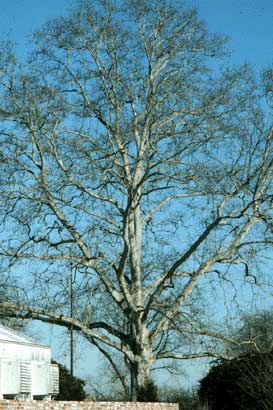Sycamore (Platanus occidentalis)
 |
The American sycamore, or Buttonwood tree, is native to the eastern part of our country. Sycamores grow very rapidly, sometimes 70 feet in their first 20 years. They are likely to reach 100 feet at maturity and spread on huge, gnarled branches as wide or even wider than they are tall. After they are 10 years old, as they grow, they shed their bark in large patches, creating mottled trunks of cream, tan, and olive green-- a sort of calico bark. The fallen bark and large leaf litter may be toxic to turf grass in the area, so clean them up promptly. It does not seem to bother ground covers under the tree, just turfgrass.
Sycamores have large, coarse leaves. Resembling maple leaves in shape, they have 3 to 5 sharply pointed lobes and may measure up to 10 or 12 inches long and 6 or 8 inches across. Sometimes they are broader than they are long. They have smooth, dull medium green surfaces and paler undersides with hairy veins. They emerge in late spring, most dropping in November, although a few may persist until very late winter. . They are not known for having particularly good fall color.
 |
Sycamore flowers emerge in late May or early June about the same time that the leaves emerge. They are formed in round clusters about 1 inch in diameter. A yellowish green, both male and female flowers are inconspicuous. The clusters develop over the season into seed balls that are pale brown and fuzzy. About 1 to 1/2 inch around, they are green at first, turning brown as the seeds within mature. These balls hang on the tree, one to a stalk, through the fall and much of the winter before beginning to shed their seeds in the spring. When they break apart they release windborne hairs which may irritate ears, eyes, noses and throats of people who are sensitive or allergic. They are not attractive to wildlife.

